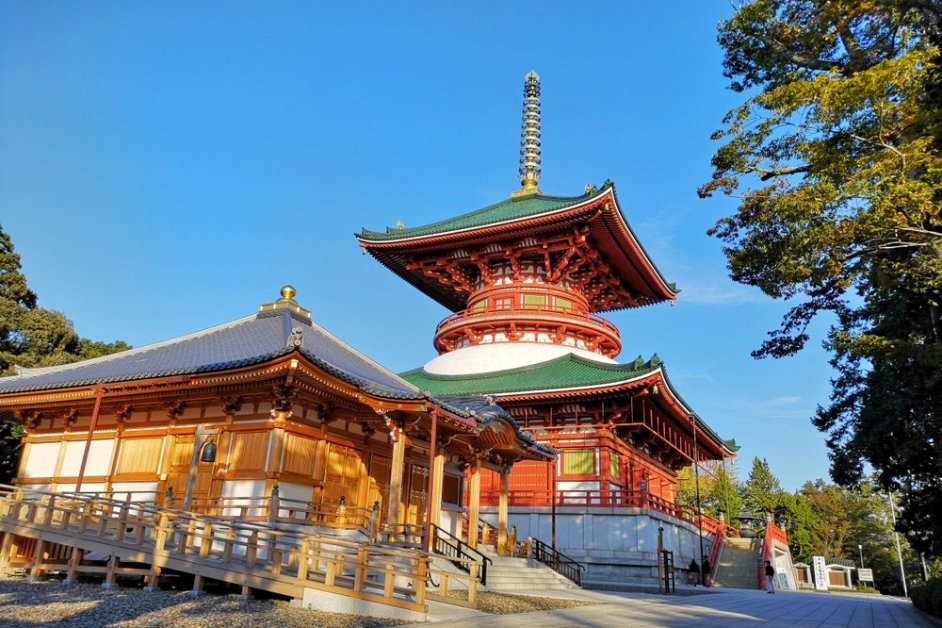
Narita Gion Matsuri 2026
Narita Gion Festival, celebrated for three days in July, features elaborate festival floats, omikoshi portable shrine processions,..

Naritasan Shinshoji Temple (成田山新勝寺) is a Shingon Buddhist temple complex founded in the 10th century. This historic site is located in Narita City, Chiba and about a 20 minute walk from JR Narita Station. Due to the station’s close proximity to Narita Airport, the temple is a perfect spot for travelers to sample the area’s rich culture during long layovers. The renowned temple is a must-see and known as the second most visited temple in Japan, after Meiji Shrine.
The journey to Naritasan is a cultural experience in itself. After exiting JR Narita Station, visitors must walk along Omotesando, which is a pleasant street lined with traditional craft shops and restaurants — some serving freshly grilled eel dishes. Once visitors reach the temple, they are greeted by Niomon Gate, a grand structure whose presence hints at the notable buildings and relics within.
Explore Naritasan’s highlights, though if time permits, guests should explore the entire temple and dedicate some time to prayer for an immersive and spiritual experience.
While impressive in size, the Great Main Hall's (Daihondo) exterior of woodwork and white coloring is more simplistic than its surrounding buildings. Inside, the prayer hall houses a statue of Fudo Myo-o, one of the site’s most important artifacts. It is customary for worshippers to bow before and after praying to the great deity.
The Fudo Myo-o statue in Daihondo is an important Buddhist deity said to be carved by Kobo Daishi, the founder of the Shingon sect of Buddhism. Legend goes that the impressive statue found its home at Naritasan after Kancho Daisojo brought it to Narita to pray, and it refused to move. Fudo Myo-o takes on the appearance of the highest Buddha of Shingon Buddhism. The deity’s muscular body, deep blue skin tone, and angry expression, while intimidating, are meant to remove worldly desires from worshippers.
Standing beside Daihondo Hall is Naritasan’s Three-Story Pagoda, which has an opulent exterior that is truly mesmerizing. Golden dragon heads protrude from the sides of the pagoda with intricate patterns of red, blue, green, and gold seamlessly flowing around them. The pagoda is dedicated to the Five Wisdom Nyorai (Buddhas).
Further into Naritasan is the Great Peace Pagoda, or Heiwadaito, a relatively recent addition built in 1984. Similar to many buildings at Naritasan, the tower’s exterior is decorated vibrantly with red detailing, which contrasts its green roofs. Apart from enjoying the building’s aesthetic, visitors can also enter the building to pray.
Just beyond the Main Hall is Naritasan Park. This huge wooded area is the perfect extension of the temple’s sacredness with its winding paths, peaceful nature, and centralized pond.
Discover Naritasan ParkOne of the temple’s most sacred rituals is the Goma Fire Ritual, which is a special Goma prayer offered to Fudo Myo-o. In this ceremony, people provide their prayers and wishes on wooden sticks to the temple’s monks who burn them in a consecrated fire while chanting mantras. This purification ritual is symbolic of burning away participants’ unnecessary worldly desires to aid them in achieving a simple and happy life. The fire used in Naritasan’s Goma Fire Ritual is especially significant as it is said that it was used in a Goma prayer that ended war in the Kanto region over 1,000 years ago during the Heian period. Naritasan’s monks have kept the same flames burning with daily Goma prayers to this day.
8-minute walk from Narita Station, via Narita Omotesando.

Narita Gion Festival, celebrated for three days in July, features elaborate festival floats, omikoshi portable shrine processions,..

The Naritasan Temple is well worth a visit, and not just for those filling in time while waiting for a plane. The temple groun..

Temples, gardens, gift shops, Japanese traditional restaurants – all these are only minutes away from Narita International Air..
 8
8
Old and important temple complex in Narita that spreads over a wide area offering some amazing sights.
 6
6
Naritasan Shinshoji Temple is a Buddhist temple complex very close to Keisei Narita Station—beautifully captured here in black..

Naritasan Shinshoji Temple really took me by surprise. I've never heard before that there is an ancient picturesque temple..
 9
9
Naritasan has over 400 plum trees, which start blooming in late February and signal the beginning of spring.
 8
8
Exploring the Naritasan Temple Complex and Beautiful Japanese Gardens - a great experience whether waiting for a flight or vis..

Hotel MyStays Premier Narita is located close to Narita airport and provides a free regular shuttle bus to and from both the airport..

The Hilton Tokyo Narita Airport Hotel is sitting almost right at the entrance to Narita International Airport Chiba.

Less than an hour from the airport to step back in time to the world of the Edo period (1603 to 1868). From Narita, a short trip..

It's worth stopping by in Narita itself to sample one of the local specialities at Kawatoyo (川豊).

With international travel proving difficult or impossible at the moment, many people are turning to international cuisine to get..

From late April until the end of June, you can experience a slice of Americana at the at ANA Crowne Plaza Hotel Narita "American..
 10
10
Escape the crowds of Naritasan Temple by stepping into Naritasan Park (Narita-san Kōen). In summer, the park was beautiful, wi..

An incredible shopping and eats street like Narita, made for people in a hurry, may not be the ideal place to pay tribute to an..

Narita is not just an airport, but a nice town with Naritasan temple and Japanese garden.
Your feedback has been sent.